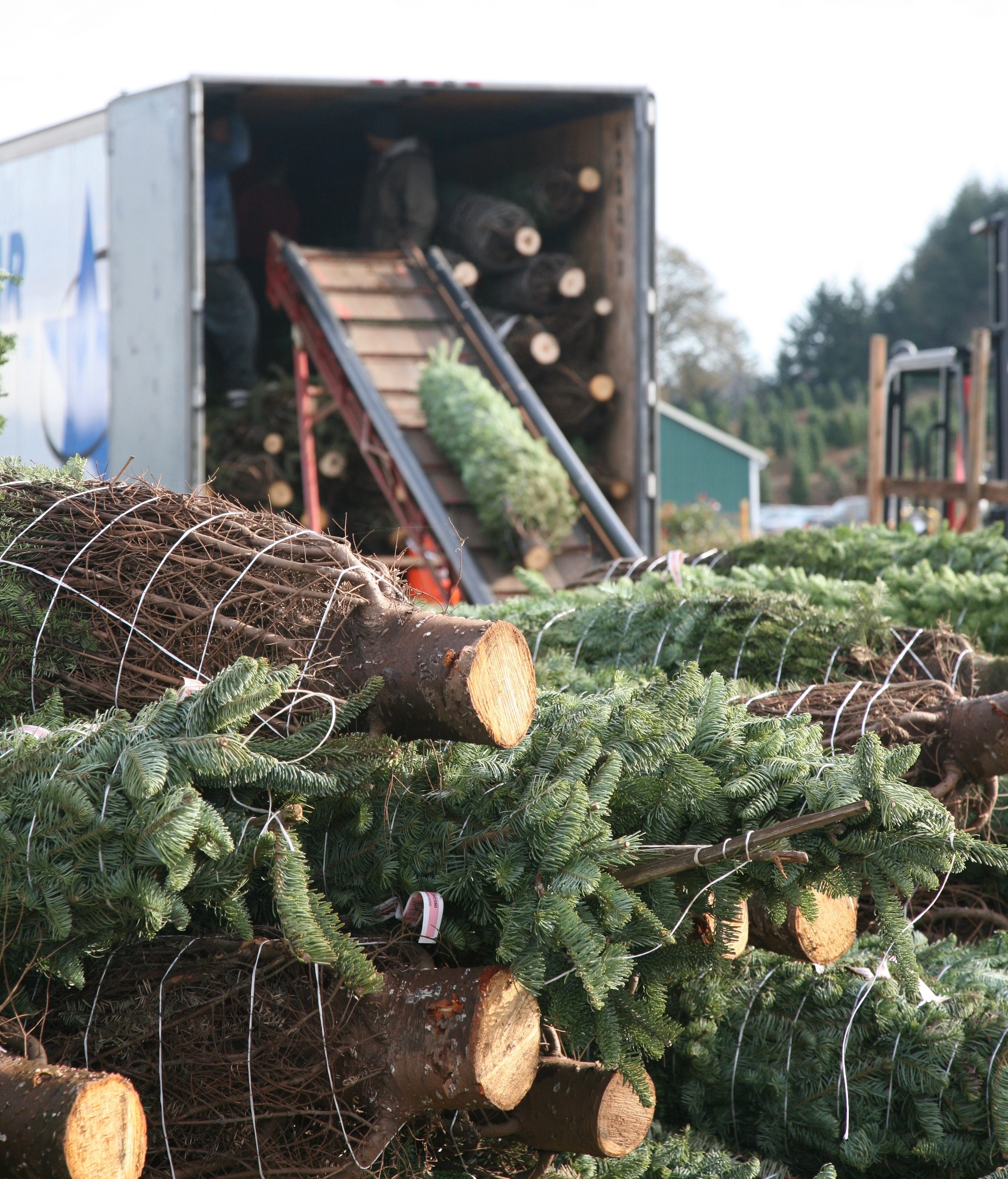The Global Christmas Tree Trade Starts With Helicopter Harvesting

Helicoptering firs into transport trucks for sorting and packaging. (Photo: Noble Mountain Tree Farm)
Getting a Christmas tree from a farm in Oregon to a hotel in Dubai might seem like a hassle, but these days, with the help of helicopters, health inspections, and refrigeration, it’s a breeze.
Oregon is the number one producer of Christmas trees in the U.S., with an annual harvest of six to seven million trees valued at around $110 million. Most of these festive firs—the Douglas, Noble, and Fraser being the favorites—are grown in the Willamette Valley, whose fertile soils, abundant water, and long, temperate growing season make for ideal conditions. Here, preparing for Christmas is a year-round endeavor.

Oh, the Christmas spirit! (Photo: Noble Mountain Tree Farm)
Bob Schaefer has worked for the past 42 years at Noble Mountain Tree Farm, a 3,400-acre Christmas tree farm in Salem, Oregon. Schaefer, who is the general manager, explains that while we tend to think of Christmas trees as tidy and conical, they grow up wild and ugly if left to their own devices. After planting, fertilizing, and waiting seven to 10 years for the trees to grow to the right size, workers use a shearing knife to coax the plant into that ideal conifer shape we know so well, trimming the bottom foot of branches to create the “handle” for the stand.
Before Oregon’s trees go anywhere, they need to be inspected for pests and diseases. Gary McAninch, Nursery & Christmas Tree Program Manager for the Oregon Department of Agriculture, explains that his team must check for hitchhikers before the trees are relocated—slugs, yellow jackets, and weevils. A month or two prior to harvest, they look at a representative sample of the trees for odd coloring, unusual needle drop, insect entrance and exit holes, and other unhealthy symptoms.

Roping trees together in preparation for the helicopters. (Photo: Noble Mountain Tree Farm)
Starting in August or September, growers go through the fields and grade the trees for their salability. Cutters then chainsaw the ones that have been graded and tagged (20 to 30 percent meet the standards each year), with one person toppling about 1,500 trees a day. Crews then bundle and loop 10 to 12 trees together in a rope sling, which is then hooked up to a helicopter.
Noble Farm puts out over half a million trees every year, says Schaefer, and for farms like theirs with large, long fields and very few roads, harvesting by hand isn’t realistic. Helicopter harvesting began in 1976 and has been a huge benefit to the industry, he says. Noble Farm hires two full-time helicopters and one or two part-time ones; even smaller growers with as few as 5,000 trees now use helicopters, says Schaefer. Before helicopters, labor-intensive hand-harvests typically began back in October.

Thousands of firs preparing for Christmas in Oregon’s Willamette Valley. (Photo: Noble Mountain Tree Farm)
The helicopters transport the trees to a processing area, where bailing machines individually wrap the trees in twine. Trees are loaded up onto trucks, vans, or containers for rail transport based on their size, species, and grade. Noble Mountain Tree Farm prefers using refrigerated trucks (ideal temperature: 35 degrees), but sometimes must resort to vans filled with shaved ice during peak season. From there, the firs make their way to distribution centers and stores around the U.S. The ones destined for ports abroad are directed toward refrigerated container ships.
All of this has got to happen quickly in order to keep the trees as fit and fresh as possible for delivery.
Oregon’s dead conifers decorate the globe. According to McAninch, somewhere around one million, or 14 percent of the state’s trees end up in Mexico, while half go to California. Others find their way to places like Guatemala, Singapore, Dubai, Malaysia, Palau, the United Arab Emirates, and Vietnam.

All twined up and ready for the refrigerated trucks and shaved ice vans. (Photo: Noble Mountain Tree Farm)
Gone are the days when most families grabbed saws and traipsed into the forest in search of a Christmas tree. Now, farms place perfectly pruned trees right at our feet, and more and more stores offer plug-in plastic alternatives. Schaefer thought that artificial, prelit trees would bring the farm’s demise, but their market share has yet to go down. “We’ve actually had a lot of our retail customers say they get tired looking at the same old tree every year,” he says.
What kind of Christmas tree does Schaefer prefer? “I look for what my wife wants. She always wants a Noble Fir, a natural looking, layered tree,” he says. “I’ve got five million trees to choose from—so I can usually find something.”












Follow us on Twitter to get the latest on the world's hidden wonders.
Like us on Facebook to get the latest on the world's hidden wonders.
Follow us on Twitter Like us on Facebook